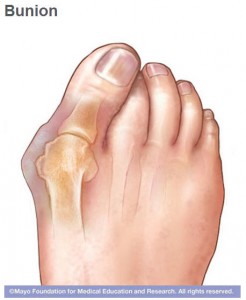-
Tuesday Q and A: With painful bunions, try other measures before turning to surgery
 DEAR MAYO CLINIC: I have had bunions for years, but they have not bothered me much until recently. I now have pain every day and most shoes hurt my feet. Is surgery the only option at this point? What does that involve, and can it be done on both feet at the same time, or will I need to have each foot done separately?
DEAR MAYO CLINIC: I have had bunions for years, but they have not bothered me much until recently. I now have pain every day and most shoes hurt my feet. Is surgery the only option at this point? What does that involve, and can it be done on both feet at the same time, or will I need to have each foot done separately?
ANSWER: In a situation like yours, surgery could be considered. But surgery is not the only treatment for bunions. More conservative measures may help decrease your symptoms and relieve pain. If you try them and they don’t work, though, then it would be a good idea to talk with a foot surgeon about surgical options.
The structure of your feet changes over time. Sometimes these are subtle changes that you do not notice. But in other instances, the changes are more substantial. Bunions happen due to changes that force the bones of your feet out of alignment and increase the width of your foot.
When a bunion develops, your big toe actually tilts or drifts away from the midline of your body, eventually crowding the second toe. The bone that is just behind the big toe, called the first metatarsal, drifts or tilts in toward the midline of your body. As the first metatarsal tilts in, it becomes more prominent. That is the bony bump referred to as a bunion.
Bunions are not always painful. As you describe, some people have them for a long time without any bothersome symptoms. But bunions may become painful for a variety of reasons. Shoes that are too narrow or too tight can make bunions worse. Skin irritation may develop on your feet due to the crowding of your toes. Over time, arthritis can develop in the big toe joint, as well. That may lead to pain and limit the range of motion at the joint.
When bunions become painful, there are several alternatives you can try before turning to surgery. First, if you have not already done so, make some changes to your footwear. To relieve pressure on bunions, try shoes with a wide toe box and soft leather uppers. If your shoes still bother you, you can have them stretched in the areas that cause irritation to make them more comfortable. Do not wear shoes with high heels or shoes that have seams in the toe box. Both can irritate bunions and make symptoms worse.
Pain-relieving medications such as acetaminophen, ibuprofen or naproxen may help control the pain of a bunion. Cortisone injections can be helpful in some cases, too. Talk to your doctor about whether they are right for you.
If these therapies do not give you enough relief, consider talking with a surgical foot specialist. The goal of bunion surgery is to reduce the foot deformity, decrease pain and increase function.
Several surgical procedures can be used to treat bunions. No one technique is best for every problem. The type of procedure that would be considered is based on the severity of your bunions. In most surgical procedures for bunions, the bones are surgically repositioned for better alignment.
Bunions on both feet can be surgically corrected at the same time or at separate times. It is up to you and your surgeon to decide which approach is best for you. — Martin Ellman, D.P.M., Orthopedic Surgery, Mayo Clinic, Rochester, Minn.
Related Articles







